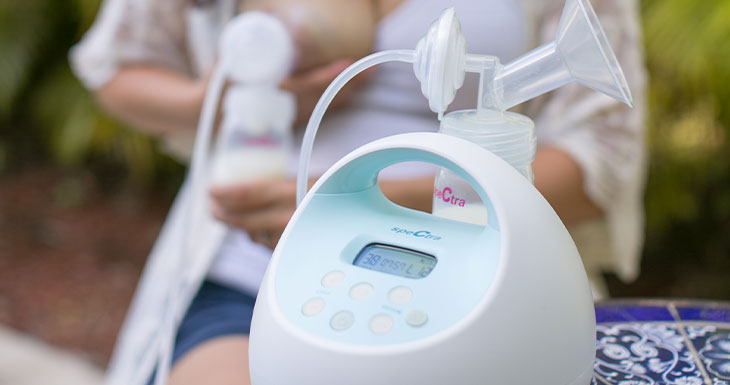Sisters, Not Twins

Melissa Portunato MPH, IBCLC, RLC
Breasts are asymmetrical which means they can come in different shapes and sizes. They can also vary from side to side too! They’re sisters not twins. In fact, it’s pretty common for breasts to be uneven by a cup size or less, and more than half of women have some variation between breast size. No matter the size and shape of your breasts and nipples, rest assured mamas they are perfect for your baby.
Factors that contribute to shape and size
During puberty, a girl’s breasts will begin to bud right under the nipple. It’s not unusual for one breast to start to develop first. Breast unevenness during puberty is normal and usually improves over time. A person’s genetics, body fat, and age can all influence the shape of the breasts, areolae, and nipples. A few of the most common breast shapes include: bell shaped, athletic, slender or tear dropped shaped. Nipples can be elongated, short, wide, flat or inverted. Moms can even have a supernumerary or extra nipple! Breasts / nipples types can vary from side to side and can have a combination of types and features.
Changes in Pregnancy and Breastfeeding
The response to fluctuating hormone levels such as with pregnancy and breastfeeding can influence changes in breast characteristics. During the first trimester (1-12 weeks), as a mother’s body starts to prepare for breastfeeding, breasts can become tender and sensitive. This is usually the first indication a mom might think she’s pregnant…sore breasts. As estrogen and progesterone levels continue to rise, the size of the breasts will increase and moms can sometimes continue to feel tenderness and swelling as the months progress. Pregnant moms will notice as they get closer to delivery their nipples and areolae will begin to darken. Why does this happen? Pregnancy hormones can cause skin pigment to darken making the areola a direct bullseye to baby’s food source! Your breasts!
The size of your nipples will also change when you begin to breastfeed. We recommend sizing your nipples about 1-2 weeks after delivery to find the right flange fit. Check out our sizing guide! It’s normal for nipple size to fluctuate throughout your breastfeeding journey especially when there are changes to your routine. Skipping the middle of the night pump, returning to work, or transitioning to exclusively pumping can be some examples that can impact the shape of your nipples. The return of menstruation can also cause tender or swollen breasts / nipples as well as temporary dips in supply. Resizing your nipple diameter and switching flanges sizes can be helpful to keep you pain free.
But what about milk output? What’s normal?
Babies between 1-6 month old will consume between 25-30 ounces per day of breastmilk. This is a great goal for moms exclusively pumping and wanting to keep up with baby’s intake. Moms who exclusively pump or pumping for a missed feed will see about 3-4 ounces (combined, both breasts) each pumping session. While moms who pump in addition to nursing at the breast will see about half (.5-2 oz , combined both breasts).
Pumping and Flange Sizing
Breast and nipple size can vary on each side and it’s quite common for moms to respond differently with adjusting cycles on each side. It can be frustrating but quite common for one breast to produce more milk than the other. Do you notice one breast is producing significantly more than the other? Check out our previous blog When One Breast Produces More Than The Other. Sometimes moms will need to use different flanges on each side to accommodate and that’s OK! Maybe one side is more prone to clogged ducts or one nipple is more elastic. Troubleshooting the flanges can help! Lubricating with coconut oil can ease discomfort and create a better seal. Repositioning flanges while pumping may also be necessary to keep the nipple centered and milk flowing freely. Tip: Instead of double pumping, try single pumping for 15 minutes on each side while keeping it steady on expression 54. Try the other breast steady on expression 38. Vacuum is always to comfort. Is there a side that responded better? Single pumping allows for more concentration on one side and can help find your “magic Spectra number.” Don’t forget to use your hands before, during and after!
It’s important to know the signs when something isn’t right. Perform routine self breast examinations and keep up with your yearly well checkups. Studies tell us, breast / nipple shape and size typically return back to normal after breastfeeding. Phew! That’s encouraging news! Remember mamas your breasts are sisters not twins! Your body is perfectly designed to create, birth and feed your baby.
Got questions about flange sizing? Are you having pain when pumping? Connect with our free lactation services hosted by an International Board Certified Lactation Consultant. You’re not alone on your breastfeeding journey. We’re here for you and we support you!
Sources:
de Holanda AA, Gonçalves AK, de Medeiros RD, de Oliveira AM, Maranhão TM. Ultrasound findings of the physiological changes and most common breast diseases during pregnancy and lactation. Radiol Bras. 2016;49(6):389-396. doi:10.1590/0100-3984.2015.0076
Butte NF, Garza C, Smith EO, Nichols BL. Human milk intake and growth in exclusively breast-fed infants. J Pediatr. 1984 Feb;104(2):187-95. doi: 10.1016/s0022-3476(84)80990-7. PMID: 6694010.
https://www.healthline.com/health/breast-shapes



Leave a Reply
Want to join the discussion?Feel free to contribute!